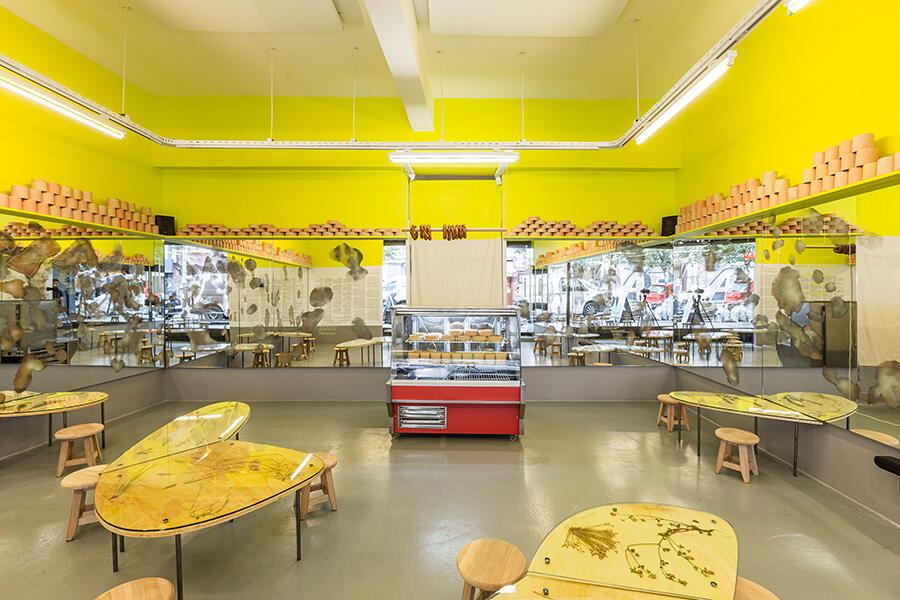The Low-Maintenance Languor of the 17th Istanbul Biennial
Archival research projects and the city’s historic venues were the highlights of this year’s somewhat inert biennial
Archival research projects and the city’s historic venues were the highlights of this year’s somewhat inert biennial

This year seems to be one of slow creative fermentation, diffuse, low-intervention curation and the mycelial development of ideas. At documenta in Kassel, artists’ collective La Intermundial Holobiente chose the site of a municipal compost heap (one managed by the landscape gardeners of Kassel’s MHK museum complex) to construct a reading room for their polyphonically edited publication, The Book of the Ten Thousand Things. At the 17th Istanbul Biennial, this schema was extended to an entire exhibition. Rather than the principle of coming together, the Biennial’s curators instead espoused one of creative sporing, dispersing 54 artists and collectives across 13 venues in the hope that something takes root.
Their aim, as the honeyed curatorial statement puts it, was to ‘learn from the Earth’s slow chemistry of renewal and nourishment […] Let this biennial be compost.’ At the opening press conference, staged in a medicinal garden, co-curator David Teh described how ‘Compost is something you bring together but also something you need to leave alone’. His curatorial team, however, mostly did the latter. The Biennial had no title or unifying theme, and while there is a certain honesty in that, it did give the show a rather lazy, languorous feel like one of the city’s many stray dogs snoozing in the sun.

There were archives aplenty, the best of which indexed liberation movements, such as the Nepali Picture Library’s The Feminist Memory Project (2018–ongoing) at Pera Museum. The same venue also featured Sim Chi Yin’s multimedia project One Day We’ll Understand (2016–ongoing) — despite its stern, museological feel, a remarkably stirring exploration of the anti-colonial guerrilla war waged in British Malaya in the mid-20th century — and Lida Abdul’s simple yet striking short films, including White House (2005), in which the artist paints the ruins of an Afghan government building bombed by the US military.

For much of the time, the rich historical charge of the host venues threatened to overwhelm the work. For example, located in what was once the heart of Istanbul’s print industry, Barın Han was home to pre-eminent calligrapher and book-binding artist Emin Barın, whose preserved office felt much more compelling than most of the archive-heavy artworks that the building had been crammed with. Notable exceptions were Christian Nyampeta’s The Evening School: Sound Archives of Black Literature (2022), an installation that invites visitors to listen to recordings of the works of novelists Aimé Césaire, Ahmadou Kourama and Edouard Manick. Also, Pratchaya Phinthong and Chairat Polmuk’s The Glossary of Ancient Isan Proverbs (2022), an installation in which a printer continuously discharges Thai aphorisms in disappearing ink.

Elsewhere, certain sites provided effective atmospheric support to the work, as in Marco Scotini’s Disobedience Archive (2005–ongoing). This project gathered decades of footage of protest and creative resistance in the former Central Greek High School for girls, a 19th-century building that had stood undisturbed since 1999. Scotini collaborated with artist Can Altay on repurposing the interiors; pint-sized school desks, for example, held tablets that showed the work of radical activists and artists such as Argentina’s Grupo de Arte Callejero and the UK’s Black Audio Film Collective. But the profusion of the school’s nationalist memorabilia, such as posters, busts and portraits of military leaders from the era of the rule of Kemal Atatürk (1923–1938) reinforced a palpable sense of state power.

The biennial also de-emphasized the visual with a number of powerful sound works, many installed in sumptuously refurbished hammams and incorporating underwater recordings, as with Waters’ Witness and Whispering Playground (both 2022) from Tarek Atoui and Taloi Havini’s Answer to the Call (2021). I loved Evrim Kavcar and Elif Öner’s A Dictionary of Sensitive Sounds (2019–ongoing), especially the translation of hyper-specific sonic descriptions such as ‘the sound of a detergent foaming out of the pores of a kitchen sponge when you squeeze it’ into interpretive dance on film. Also effective was Carlo Casas’s immersive Cyclope (2022), which integrated field recordings and sonic crowd-control devices in a long, cool subway tunnel-turned-exhibition space that gave me the sensation that I was being disembowelled by sound.

A few works referenced food and cultivation, such as Cooking Sections’ Wallowland (2022), which charted the wetlands – and, by extension, the pastoralists and water buffaloes that call them home – on the city’s outskirts. This delicate biosphere is currently under threat from President Erdoğan’s scheme to build a major shipping canal between the Black Sea and the Sea of Marmara. Cooking Sections’ research was presented in a reimagined canary-yellow muhallebici – a dairy bar that sells treats made of fermented buffalo milk. An event for the Hrant Dink Foundation’s Dumpling Post newspaper (one of several pop-up biennial publications and radio channels) served up manti (traditional dumplings eaten throughout the region) and fostered discussion of journalistic suppression and freedom of speech. But if this is a biennial-as-compost-heap, it felt like one that is yet to lead to any creative ferment. All the right elements were there but when shovelled together it failed to fizz.
The 17th Istanbul Biennial is on view until 20 November 2022.
Main image: Carlos Casas, Yaklaşım Tüneli, 2022. Courtesy: the artists and 17th Istanbul Biennial; photograph: Sahir Ugur Eren
Thumbnail image: Disobedience Archive (Ders Bitti), 2022, curated by Marco Scotini in an exhibition setting by Can Altay. Courtesy: the artists and 17th Istanbul Biennial; photograph: Sahir Ugur Eren
























